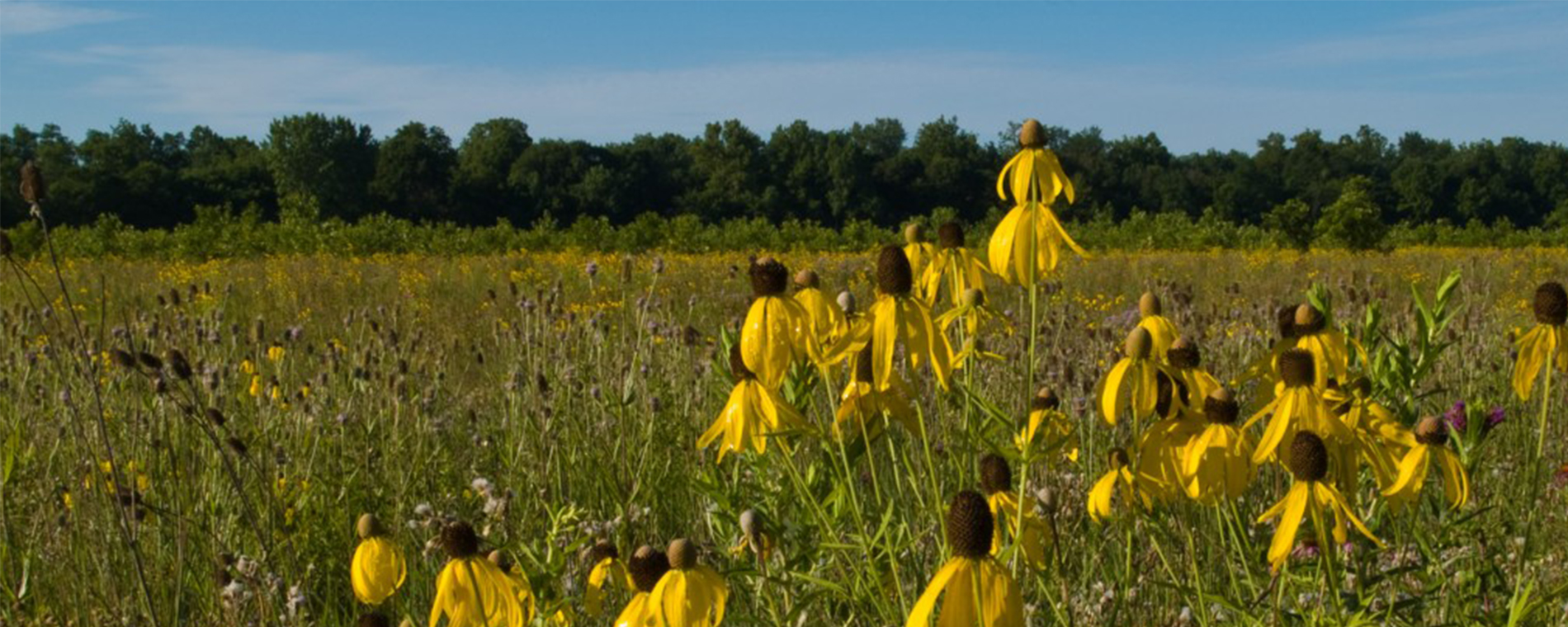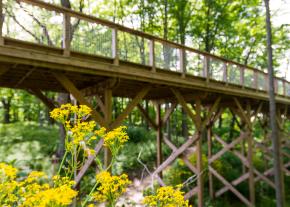The ground under your feet is a little mucky … but in that great, springtime way. All around you, trees and bushes and grasses are taking on a slightly green hue, almost an aura, as the natural world pushes to leave winter behind and start on something new. Overhead, a diverse collection of birds wing their way northward, settling in for a rest every now and then before continuing their trips to summer homes.
Walk along the forest edge and, in the open spaces to your left, wildflowers are beginning to bloom, bringing bright colors to the landscape; to your right, you peek into the woods to see flashes of feathered grace moving from branch to branch, flashing vivid yellows, bright blues and other colors that have been missing from the landscape for months. You follow a path into the woods, wind around a few ancient tree trunks and find yourself at water’s edge, where sparkling ripples betray the scurrying departure of ducklings in quick pursuit of their cautious mother.
And you’re doing all of this just a stone’s throw from some of the busiest thoroughfares in Hamilton County.
Welcome to Nonie Werbe Krauss Preserve, one of Hamilton County’s three protected nature areas that let the public get a glimpse of the wild side in the midst of some of the most tamed places on earth.
Along with Ritchey Woods Nature Preserve and Burr Oak Bend Nature Preserve, “Nonie Krauss” (as it’s often known) allows visitors to wander through Indiana’s natural landscape in areas that will never be developed. Protected by the state or by conservation organizations, the lands have been set aside to help preserve the state’s natural heritage and to allow visitors to enjoy Indiana’s wilder side.
Considering how easy they are to visit, these three protected areas offer a surprising array of nature experiences, including the opportunities to see endangered flora and fauna and to experience moments of genuine wonder and surprise. However, their status as “protected” areas means they also are to be protected from you: You are asked to always use marked trails, stay out of any areas designated as off-limits and do not pick any flowers or capture any wildlife during your visit.
In other words, feel free to roam and enjoy these areas, but, as people often say, “Take nothing but memories and pictures and leave nothing but footprints.” Following is an idea of what you can expect at Hamilton County’s wilder places.

Nonie Werbe Krauss Preserve
Named for one of Central Indiana’s most ardent champions of natural areas, the Nonie Werbe Krauss Preserve has a mix of wooded areas along the White River and open prairie grounds. Formerly farmland, it has been carefully curated to return it to a more natural state, with the intent of showing what Indiana used to look like.
Easy walking trails cutting through both the prairie and wooded areas (thanks in part to its frequent use as an educational area for adjacent Riverside Junior High and as a course for the school’s cross country team), Nonie Krauss offers a home to a wide variety of plants and animals, and spring brings an assortment of wildflowers to the landscape.
Formerly known as the Wapihani Preserve (from the Miami name for White River), the 77 acres of Nonie Krauss offer an idea of how a landscape can evolve. Cliff Chapman, executive director of the Central Indiana Land Trust, which manages Nonie Krauss, explains that the southern end of the preserve, for example, is taking shape as an early succession forest, still in the process of converting the ag fields that were here just a couple of decades ago. Other areas are being developed as savannah, a type of land that used to cover parts of Indiana but is now quite rare in the Hoosier state.
With this varied ecosystem, Nonie Krauss can be especially fun for people who like flying wildlife. With a patient spirit and sharp eyes, visitors can identify birds that rarely show up in your backyard, including yellow-breasted chats, Eastern towhees and blue-winged warblers. A couple of towers built in the preserve by an Eagle Scout candidate offer homes to chimney swifts, and Chapman says that Baltimore orioles can be spotted near the river, as can their unique nests, which look sort of like socks hanging from tree limbs. In addition, he notes, during the summer and early fall, the prairie areas are great for eyeing monarchs and other butterflies.
Visit
The Nonie Werbe Krauss Preserve is located at the southwest corner of 116th Street and Eller Road. Public parking is available in the parking lot behind Riverside Middle School (10910 Eller Road after 4 p.m. on weekdays and any time during weekends. Plenty of easy trails are available, but the preserve is not ADA-accessible.
Ritchey Woods Nature Preserve
Perhaps the most accessible of the three protected areas – thanks in part to its former ownership by the Children’s Museum of Indianapolis – Ritchey Woods Nature Preserve offers nine different trails where a visitor can total a little more than two miles of walking through mostly wooded areas.
With 127 acres for roaming (42 designated as an Indiana State Nature Preserve and 85 protected by a Department of Natural Resources conservation easement), Ritchey Woods is a remarkably large chunk of nature located right at the corner of 106th and Hague Road. That convenient location and the well-developed trail system and amenities mean it’s an easy way to grab a quick taste of the outdoors. “You don’t have to invest a lot of time for a quality experience,” said John Scott Foster, executive director of the Friends of Hamilton County Parks. “It’s very family-friendly.”
Like Nonie Krauss, much of Ritchey Woods is reclaimed farmland, but Foster notes that one can still find some fairly ancient trees on the property, ones that had been “anchor trees” on farm property – sometimes literally trees that were used to anchor winches for field work in times long ago. You can often identify these trees, he said, by their shape: They’re more likely to be lollipop-shaped, as opposed to the younger trees that grew up together, which probably have a shape more like a martini glass.
Fishers Parks & Recreation Chief Naturalist Danesa Stolz said that, despite being surrounded by high-traffic areas, Ritchey Woods is home to a number of rare and endangered species of plants and wildlife. In fact, of the 160 species of birds that have been documented on the property, 27 birds meet the rare or endangered criteria.
Spring is one of the best times to visit Ritchey Woods, Stolz notes, because the wildflowers are plentiful and it is also peak season for migrating birds returning to northern nesting areas. Of course, even with the well-marked and accessible trails, this is fairly untamed territory, so expect to get a little mud on your shoes, and make sure to walk the boardwalk, which lets you venture into swampy areas without wading through water.
Visit
Using the entrance on Hague Road just south of 106th Street, you’ll find a gravel parking lot with quick access to trails, which are not ADA-accessible. Stop by the little cabin for trail maps and information, and expect to find a few benches scattered throughout the preserve. The park entrance is connected to the multi-use trail that parallels Hague Road, so it’s easy to get to the preserve by bike, but bikes are not permitted on Ritchey Woods trails. So, lock up your two-wheeler in the provided bike rack while you hike.

Burr Oak Bend Nature Preserve
Perhaps the least “developed” of the three nature preserves in Hamilton County, Burr Oak Bend Nature Preserve was created from a land acquisition resulting from a 1999 incident in which chemicals dumped into White River caused a major fish kill. As such, it sits along the river and offers access to the river for canoeists, kayakers, fishermen and other recreational types.
Spring is a great time to visit the 130-acre preserve, Central Indiana Land Trust’s Chapman says, because later in the year the vegetation grows up so much that it can be hard to make your way through some areas. He adds that the effort is well worth it, though, because of the wildlife that can be seen on the property. With the river access, visitors have seen a lot of great egrets and other wading and shore birds. Little wren-like flycatchers can be glimpsed as well, a bonus because the birds had been uncommon here for decades and are making a comeback.
This time of year, Chapman says, he enjoys spying timberdoodles (aka, woodcocks) at Burr Oak Bend, although he admits that they often startle him: Small, ground-nesting wetland birds with distinctive long, pointed beaks, timberdoodles are highly camouflaged and will wait until the last minute to escape as you approach … with the result being a surprising burst of feathers flying in front of you just as you almost step on them.
In warmer months, Burr Oak Bend is a great place for frogs, including the small cricket frogs and leopard frogs, which you’ll have to look closely to see, but which you likely will hear in the evening hours.
One interesting feature of Burr Oak Bend is a project the Land Trust has undertaken to help clean up the water of White River. In an area that regularly floods – experts have calculated that the area holds up to 4.5 million gallons of water during a typical White River flood – the Land Trust has planted river bank tussock sedge, a native Indiana plant that acts as a filter for the flood water. “We are essentially cleaning the water as it goes back into the White River,” Chapman says.
Visit
Technically listed as being at 19024 Riverwood Ave. in Noblesville, Burr Oak Bend can be accessed by any one of three ways. For each option, start by heading north on State Road 37 and turning left on 206th Street. From there, you can either: stop at a small driveway just west of State Road 37 (the area is marked by a double gate); continue on and cross the river and then turn left on Riverwood Avenue until you get to the designated parking area on your left; or turn right on Riverwood Avenue after crossing the river, and continuing to the designated parking area on your right, marked as a Hamilton County Parks Canoe Launch. Regardless of where you park, you’ll find little in the way of trails at Burr Oak Bend, so the Land Trust simply asks that you walk gently and not try to clear paths by removing vegetation, downed trees or other elements of the landscape.
Note: You might be aware that, technically, there are a couple of other nature preserve in Hamilton County. However, because they are not open to the public, we are not describing them here.
For more information on the preserves we do mention here, go to Central Indiana Land Trust.







 Back to Previous
Back to Previous
